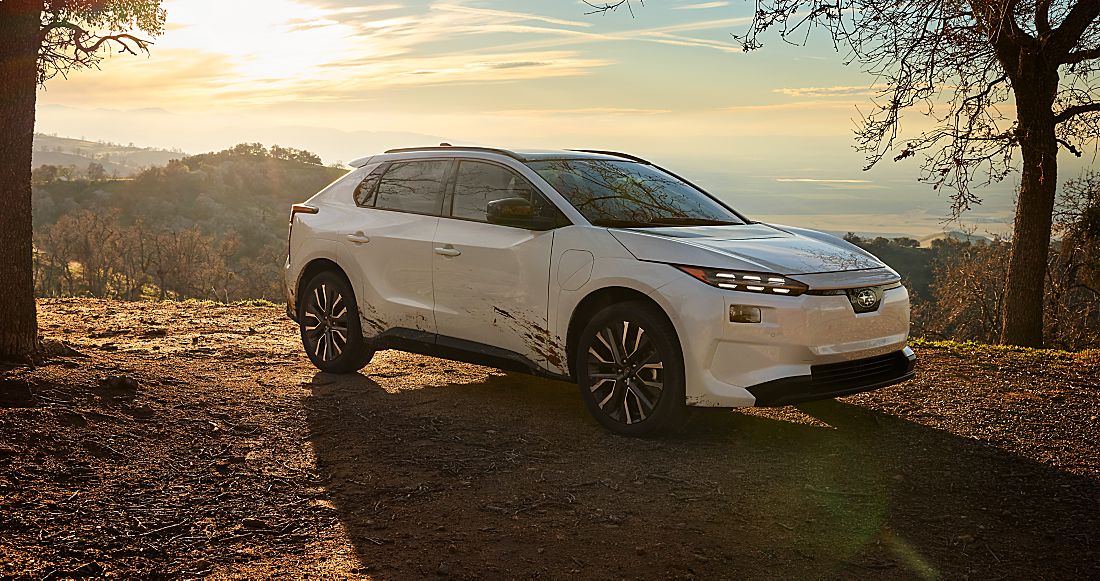Subaru Scales Back EV Ambitions
The global shift away from electric vehicles is gathering pace, and Subaru is the latest automaker to retreat. Once planning an ambitious $9.7 billion investment in EVs, the Japanese brand now says it will redirect much of that funding toward hybrids and traditional combustion models.
Subaru’s president, Atsushi Osaki, confirmed that the company will “delay the timing of full-scale EV mass production investment” amid rising hybrid demand and slowing EV sales. The move doesn’t reduce the overall budget but reframes it as a broader “growth investment.” So far, only ¥300 billion ($2 billion) has been spent, leaving ¥1.2 trillion ($7.8 billion) under review.
Subaru still plans to sell three co-developed EVs with Toyota—the Solterra, Trailseeker, and Uncharted—but its four in-house battery models are now expected to arrive after 2028.

U.S. Tariffs Hit Japanese Automakers Hard
Subaru’s shift is partly a reaction to U.S. import tariffs, which have wiped out billions in profits across Japan’s auto industry. Roughly 80% of Subaru’s global sales come from the U.S., and half of those vehicles are imported from Japan, exposing them to the 15% tariff rate. Subaru expects the policy to cut annual profits by $1.3 billion, driving a 53% year-over-year decline.
According to Nikkei Asia, Japan’s seven major carmakers lost nearly $9.75 billion in operating profits from April to September 2025 due to U.S. tariffs. Earlier this year, the rate was as high as 27.5%, only reduced to 15% after months of negotiations. Even with the lower rate, manufacturers warn that margins remain dangerously thin.
Mazda, for instance, estimates a $630 million loss—its first in five years. Nissan and Mitsubishi also reported net losses, saying they would have broken even without the tariffs. Toyota, buffered by hybrid sales, still expects tariffs to cost $9.4 billion in 2025.
Honda’s executive vice president Noriya Kaihara summed it up plainly: “The tariffs are the new normal.”

Japan’s Auto Trade Under Pressure
While the revised tariff rate has provided temporary relief, analysts warn that Japan’s automotive export model is under long-term strain. The U.S. remains Japan’s largest car market, and although many Japanese automakers have factories in North America, a significant portion of vehicles—and key components—are still shipped from Japan.
As a result, Japan’s automakers face a projected total tariff impact of $16.2 billion for 2025, according to Nikkei Asia. That figure doesn’t include the indirect financial support major automakers are extending to smaller suppliers to prevent bankruptcy.
Privately, executives worry that even a 15% rate could outlast the current U.S. administration, cementing trade restrictions that reshape Japan’s industrial strategy for years to come.
China’s “Used” EV Loophole Sparks Global Disruption
While Japanese automakers battle tariffs, China is grappling with a flood of “used” EV exports that threaten to distort the global market.
Facing a glut of unsold vehicles from over 100 domestic EV makers, Chinese exporters have reportedly labeled brand-new cars as second-hand to bypass regulatory hurdles. These zero-mile “used” cars avoid the stricter licensing and warranty requirements that apply to new exports.
According to Caixin Global, around 80% of China’s EV exports now fall under this category. The number of used EVs exported jumped from 15,000 units in 2021 to an expected 500,000 this year.
Beijing has begun closing this loophole. Starting January 1, all pure-electric passenger vehicles will face the same licensing requirements as gas and plug-in hybrid models. Regulators hope this will curb low-quality exports and force automakers to improve after-sales support and overseas service networks.
Still, some exporters say the rules remain ambiguous: used cars could still be reclassified to skirt restrictions, leaving room for continued manipulation.
Overcapacity and Quality Risks in China
China’s EV industry now suffers from too many brands, too many factories, and slowing domestic demand. Local governments continue to subsidize production to maintain employment, but that has resulted in excess supply and falling prices.
Industry veterans warn this mirrors the 1990s motorcycle boom, when Chinese firms undercut Japanese rivals with cheap bikes but poor quality—ultimately collapsing the market. Regulators hope to avoid repeating that outcome in the EV sector by tightening export oversight and promoting sustainable competition.
The Global EV Market at a Crossroads
Protectionist policies in the U.S. and overproduction in China are creating a difficult balancing act for global automakers. For Japan, tariffs make EV exports to America less viable, pushing companies like Subaru back toward hybrids. For China, overcapacity has forced a reliance on gray-market exports that threaten its reputation abroad.
Meanwhile, the expiration of the U.S. federal EV tax credit has dampened consumer demand. Without incentives, EV sales are expected to fall sharply over the next several quarters, particularly in the mid-price range where Japanese and Korean automakers compete.
If these trends persist, the result may be fewer new EV models, slower innovation, and greater dependence on existing hybrid technology. Yet, as some analysts note, downturns often precede reinvention—a potential reset for global EV strategy rather than its collapse.

What Comes Next
For now, the world’s automakers face a stark choice: absorb tariffs and keep exporting, or restructure production within target markets. Subaru’s pivot is just the beginning of a wider recalibration.
The “new normal,” as Honda’s leadership puts it, could mark a permanent shift away from globalization toward regionalized production. Whether that stifles innovation or sparks a new wave of efficiency remains to be seen—but one thing is clear: the global auto industry’s era of easy EV expansion is over.
Recommend Reading: Canada May Drop Tariffs on Chinese EVs to Aid Farmers and Boost Sales








Aktie:
Used EVs Are Now America’s Fastest-Selling Cars — Here’s Why